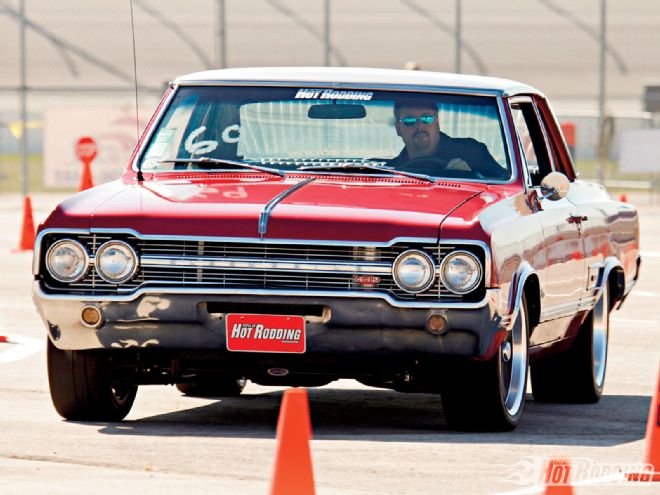
After installing a complete DSE tubular front and rear suspension kit on our '65 Olds Cutlass in the prior two issues, we stood in awe as the full-frame A-body tipped the scales at a surprisingly unsubstantial 3,408 pounds. The euphoria was short-lived, however, as the needle crept back up to 3,648 pounds after owner/photographer Robert McGaffin hopped into the driver seat. Furthermore, that number will only continue to climb after the Cutlass's 330ci mill is yanked for a 455 big-block in the future. With the DSE suspension now providing serious lateral grip, and a 500hp big-block in the works that's sure to crank out plenty of forward grunt, Project Olds now needs a big set of clamps in order to live up to its autocrossing aspirations.
As luck would have it, Baer just happened to be putting the finishing touches on its new line of Track-4 front big brake kits around the time Project Olds developed a craving for serious negative g's. In the past, Baer offered its popular two-piston Track kits for street and light-duty race applications, while its six-piston Extreme systems catered to hard-core road racers. The new Track-4 setup falls right between the two, splitting the difference between full race and full street, which describes the purpose of our Cutlass project car perfectly. The kit features 13-inch rotors, four-piston calipers, ceramic pads, stainless steel braided lines, and T-6061 billet aluminum mounting brackets and hubs. The Track-4 system should be available for most muscle cars by the time you read this, and with prices starting at just $1,095, it packs some big-time value.
That said, simply mentioning the Track-4's piston count and rotor diameter doesn't do this system justice. Based on a rugged six-bolt architecture, the two-piece caliper body is remarkably stiff for reduced deflection and improved clamping force. Furthermore, an internal fluid passage eliminates the need for an external crossover tube between each caliper half, lending an ultra-clean appearance. Since the Track-4 system is design for mixed street and track use, it uses ceramic pads that minimize dust and noise without compromising bite. Unlike race-only pads, they require very little heat to get up to proper operating temperature, yet maintain thermal stability up to 1,385 degrees. And when it comes time to swap out those pads, the Track-4 calipers are compatible with all '98-02 Camaro pad fitments. That means dozens of pad compounds from a plethora of manufacturers are at your disposal.
Since the Olds' posterior shouldn't get a free ride, we matched the beefy four-pot front setup with Baer's single-piston standard Track setup in the rear. To assist with the install, we once again turned to Brent Jarvis and the team at Performance Restorations in Mundelein, Illinois. Bolting up the front and rear kits is as easy as it gets, and it all went together in one day. When the wrenches stopped turning, Project Olds boasted a monster set of clamps at each corner for $2,670, a sum you could easily spend for just the fronts.
WHERE THE MONEY WENT Item: PN: Price: Baer A-body Track 4 front brake kit 4301381R $1,395 Baer A-body Track rear brake kit 4302112R $1,225 Baer proportioning valve 2000035 $50 Detroit Speed brake booster 050103 $375 THE COST SO FAR Description: PHR Issue: Price: '65 Olds Cutlass January 2010 $7,500 DSE four-link suspension January 2010 $2,345 DSE front suspension February 2010 $3,982 Baer front and rear brakes March 2010 $2,670 DSE brake booster March 2010 $375 Total $16,872Breaking Them In
The purpose of breaking in a new brake system is to burn off residual machining oils off the rotor surface, and relieving the internal stresses inside the rotor before subjecting them to extreme temperatures. Baer recommends easy street driving for the first 400-500 miles, with a minimum of 8-10 normal heat cycles. Zinc-plated rotors, like the ones on our Cutlass, require an additional 100-200 miles and 4-6 heat cycles. Next, it's time for the fun stuff. Baer suggests performing 10 partial stops at 40 percent pedal effort, slowing from 60-15 mph. This process should be repeated at 60 percent pedal effort. After allowing the rotors to cool with 10 miles of relaxed freeway driving, another 10 partial stops must be performed at 85-90 percent pedal effort. Once the brakes cool for several hours back down to ambient air temperature, they're ready to go.